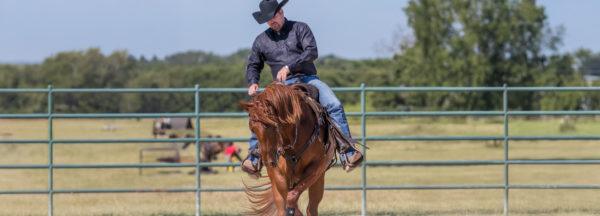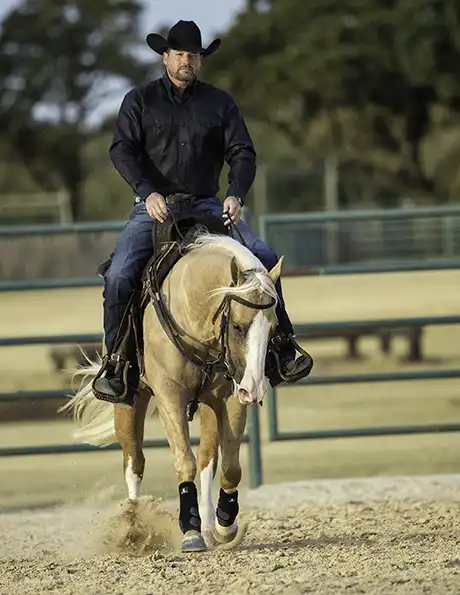Four Core Principles of Training

I’m a learn-a-holic and proud of it. I’m always looking for ways to become a better horseman and increase my horses’ performance. If another trainer can show me a technique that’s better than what I’m doing, I use it! However, just because a technique works well for one individual doesn’t mean that it’s well-suited for another. In other words, just because something works better for you and your horses doesn’t mean that it works better for me and mine, and vice versa.
Over the years, whenever I’ve considered changing a technique or adding something to the Method, I’ve always come back to the foundation Gordon McKinlay and Ian Francis taught me in Australia. It just works for me, and I think it’s better for the horses.
When I’m thinking about changing a technique or implementing a new one, I always follow what I call my core principles of training. These are the four things that are the most important to me when working with horses, and they must never be violated. I believe that every horseman should have a set of core principles that they never waiver from.
Core Principle #1: Safety for the Human
When I work with a horse, getting hurt isn’t an option. My safety, or the safety of the people I’m working with, is the most important thing in the world to me. I love my horses to death, but make no mistake, it’s the human first. When I say that out loud, I always upset my fair share of people. “Can you believe that barbarian Clinton just said that the human is more important than the horse?” Yes, I did! I can get another horse, but I can’t get another one of you or me. It’s just that simple.
Horses are large animals and have the quickest reaction time of all domesticated animals. When something goes wrong with them, it goes wrong very quickly. If you’re not careful and don’t respect them, you can get hurt or killed. I don’t fear horses, but I have a healthy respect for what they’re capable of doing.

At the top of my list, when it comes to what I hold most valuable when training a horse, is safety for human and horse.
Core Principle #2: Safety for the Horse
I never want to use a training technique that isn’t safe for my horse. Even if it’s safe for me, if it puts my horse in danger, I won’t use it. Now, do accidents happen while training horses, even if every precaution is taken? Of course they do. I’m trying to cut down on the risk of the horse or myself getting injured as much as I possibly can. There’s nothing in this world that’s 100-percent foolproof—for humans or horses.
Core Principle #3: Get Results Quickly
The Method is popular as a good rule of thumb because it gets results quickly and it’s easy to understand. Horses become respectful and safe, and their owners gain confidence and have fun. There are other training approaches out there that get results too, but they take five times as long. If you’re retired and you’ve got nothing to do and all day to do it in, you don’t care how long a training approach takes. If it takes you nine hours to load a horse in the trailer using a bucket of grain and you like that technique, good for you! For those of us who have limited time to spend with our horses, it’s important that we find a technique that gets results relatively quickly without putting our safety and our horses’ safety in jeopardy.
Core Principle #4: Horse Remembers What You Taught Him the Next Day
If you teach a horse something today and he doesn’t remember the lesson the next day, your technique was useless. Even if it took two minutes to teach the horse something, if tomorrow you come back and start the lesson and he has no clue what you’re asking him to do, it wasn’t effective.

Many horses just need the right training to develop into great horses, and that’s where the Method comes into play.
Anytime I add a technique or change something in the Method up, I always ask myself if it violates my four core principles. If it violates even one of them, I won’t implement the technique. Even if it gets results faster than what I’m currently doing, if it isn’t safe for me or for the horse, I won’t use it. Or, it may be safe for me and for the horse, but if it’s a technique that the horse doesn’t remember the next day, it’s pointless.
There are a lot of ways to train a horse. The Method isn’t the only way to train a horse and it isn’t the best way for everyone. It’s just the way that works best for me and for a lot of other horsemen. Every horseman has to know what’s important to them when working with their horse. For me, it’s my safety, the horse’s safety, getting results quickly and making sure the horse remembers the lesson the next day.
Over the past 27 years, I’ve had everything from the rankest, most dangerous horses in the world to the most docile, laid-back horses to work with. I’ve trained thousands of horses and people, and I know the Method works on any horse of any breed and age. So while I’m constantly looking for ways to better my horsemanship and take every opportunity I can to learn from as many horsemen as I can, I never waiver from my core principles of training.

I expect the training techniques I use to get results relatively quickly.

